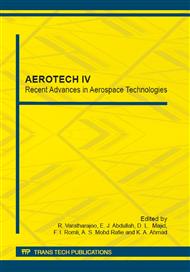p.195
p.201
p.207
p.213
p.219
p.225
p.233
p.239
p.245
Composite Repair of Curved Stiffened Aluminum Panels under Combined Tension and Shear Cyclic Loadings
Abstract:
In this study, finite element method is used to investigate the fracture analyses, crack growth trajectory and fatigue life of curved stiffened panels repaired with composite patches subjected to combined tension and shear cyclic loadings. For this purpose, 3-D finite element modeling are performed for consideration of real 3-D crack-front in general mixed-mode conditions. Contact elements are used between the crack surfaces on two crack sides to prevent interferences of crack surfaces and a complementary program was developed to handle the automatic fatigue crack growth modeling. The effects of various patch layups and shear-tension loading ratios on fracture parameters of the aluminum panel are investigated. It is shown that in low shear to tension ratios like 0.4, the patch layup of [90]4 (perpendicular to the initial crack) is more efficient than the patch with layups angle along the tension loading. As the shear to tension ratio increases, effect of patch layups with orientations of almost perpendicular to the crack trajectory on fatigue crack growth life is increased comparing with the patch layups parallel to the tension orientation like [90]4.
Info:
Periodical:
Pages:
219-224
Citation:
Online since:
November 2012
Keywords:
Price:
Сopyright:
© 2012 Trans Tech Publications Ltd. All Rights Reserved
Share:
Citation:


